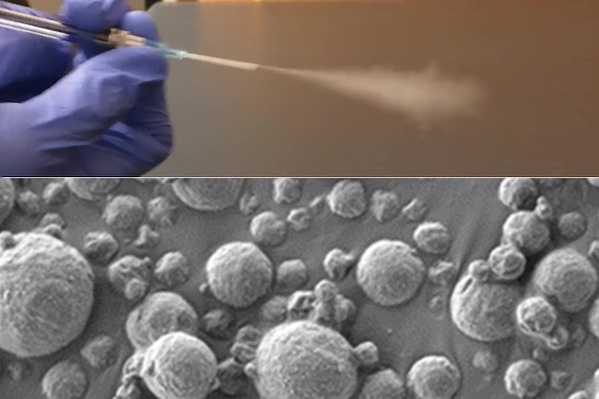Novel Diagnostic Combines Inhalable Sensors with Urine Test for Early Lung Cancer Detection
January 10, 2024
Source: drugdu
 331
331
 Cancer, particularly lung cancer driven by pollution and smoking, is expected to increasingly afflict populations in low- and middle-income countries. To catch lung cancer at its earliest and most treatable stages, it's recommended that heavy smokers over 50 years get annual CT scans. Yet, many in this demographic do not undergo these scans, and the high rate of false positives from the scans can lead to unwarranted and invasive follow-up tests. Now, a breakthrough diagnostic method that combines inhaling nanoparticle sensors with a simple urine test can detect the presence of a tumor. This innovative approach, which could potentially replace or complement low-dose computed tomography (CT) scans, could be especially promising for regions with limited access to CT technology.
Cancer, particularly lung cancer driven by pollution and smoking, is expected to increasingly afflict populations in low- and middle-income countries. To catch lung cancer at its earliest and most treatable stages, it's recommended that heavy smokers over 50 years get annual CT scans. Yet, many in this demographic do not undergo these scans, and the high rate of false positives from the scans can lead to unwarranted and invasive follow-up tests. Now, a breakthrough diagnostic method that combines inhaling nanoparticle sensors with a simple urine test can detect the presence of a tumor. This innovative approach, which could potentially replace or complement low-dose computed tomography (CT) scans, could be especially promising for regions with limited access to CT technology.
Developed by the Massachusetts Institute of Technology (MIT, Cambridge, MA, USA), this new technology is the culmination of a decade's work on nanosensors aimed at cancer and other diseases diagnosis. These nanosensors are polymer nanoparticles coated with a reporter, such as a DNA barcode, which is cleaved from the particle when it encounters proteases, enzymes often found in higher levels in tumors. The resulting reporters gather in the urine for easy detection with a paper test strip. Unlike previous versions designed for intravenous administration, these sensors for lung cancer diagnosis can be inhaled, making them more accessible and deployable in low-resource settings. The researchers developed two formulations of the particles: one as a solution for nebulizer delivery and another as a dry powder for inhaler use. Once inhaled and absorbed into lung tissue, the particles interact with any present proteases. These proteases, overactive in tumors, cleave the DNA barcodes from the sensors, which then circulate in the bloodstream until excreted in the urine.
To circumvent the need for mass spectrometry, which might be unavailable in low-resource areas, the researchers developed a lateral flow assay for the barcodes, detectable using a paper test strip without requiring urine sample pre-treatment or processing. The diagnostic system was tested in mouse models which were genetically engineered to develop lung tumors similar to human ones. The researchers used a machine learning algorithm to analyze 20 different sensors targeting various proteases. They identified a set of four sensors that could accurately diagnose early-stage lung tumors. While more sensors might be necessary for human diagnosis, this could be achieved using multiple paper strips, each detecting different DNA barcodes. Going forward, the researchers aim to test their sensors against human biopsy samples to confirm their efficacy in detecting human cancers. They also plan clinical trials with human patients. This novel technology could significantly enhance lung cancer screening worldwide, especially in areas with limited access to advanced imaging technologies, offering results in a single visit.
“We were really pushing this assay to be point-of-care available in a low-resource setting, so the idea was to not do any sample processing, not do any amplification, just to be able to put the sample right on the paper and read it out in 20 minutes,” said Sangeeta Bhatia, the John and Dorothy Wilson Professor of Health Sciences and Technology and of Electrical Engineering and Computer Science at MIT. “The idea would be you come in and then you get an answer about whether you need a follow-up test or not, and we could get patients who have early lesions into the system so that they could get curative surgery or lifesaving medicines.”
Source:
https://www.labmedica.com/molecular-diagnostics/articles/294799837/novel-diagnostic-combines-inhalable-sensors-with-urine-test-for-early-lung-cancer-detection.html
Read more on
- Phase III Clinical Trial of Recombinant Staphylococcus Aureus Vaccine Progressing Normality January 21, 2026
- Its drug marketing application for injectable iza-bren has been accepted January 21, 2026
- Kain Technology withdrew a drug registration application, resulting in a profit reduction of 111 million yuan in 2025 January 21, 2026
- Received Notice of Approval for Drug Clinical Trial January 21, 2026
- Breaking news! AstraZeneca to be delisted from Nasdaq. January 21, 2026
your submission has already been received.
OK
Subscribe
Please enter a valid Email address!
Submit
The most relevant industry news & insight will be sent to you every two weeks.



